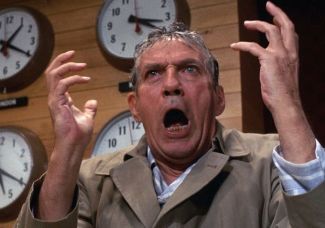Twilight of the Unwoke Guys
From The New CriterionLet’s begin with an update to a piece which ran in this space just a year ago (see “Putting Down the Big Dog” in The New Criterion of January, 2018). One year after I wrote of a Stormy Daniels-inspired revival of interest in the long ago story of President Bill Clinton’s (and Governor Bill Clinton’s and Attorney General Bill Clinton’s) sexual transgressions — the story from which the left had been insisting ever since that we all must “Move On” — the A & E network ran a six-part mini-series on the same subject titled “The Clinton Affair.” It seems not unreasonable to suppose that the motivation behind this latest revisiting of the notorious “affair” between Mr Clinton and the eternally “22-year-old intern” Monica Lewinsky is not unconnected to the ongoing campaign by progressives to bring down Mr Clinton’s successor in office, Mr Trump, whose own past sexual shenanigans, they hope, may be found to include something, anything, that will succeed in producing such a consummation, so devoutly to be wished, where Mr Clinton’s failed. But that doesn’t make its new-found respect for Mr Clinton’s accusers, no doubt partly inspired by the #MeToo movement, any less valuable.
Amanda Hess of The New York Times introduced her review of “The Clinton Affair” by writing that the series “lacks a point of view. It is straightforward in style and evenhanded in tone. Strangely, this recommends it.” From that word “strangely” you can learn everything you need to know about The New York Times’s own addiction to politically tendentious “narratives” rather than straightforwardness of style. But it also tells us that the Times, as contemptuous as the rest of the media and the Democratic party towards Mr Clinton’s accusers when he was in office, has now itself become more “evenhanded in tone” about their various accusations.
It’s not surprising that Ms Hess was unable to detect a point of view, since the series’ point of view so closely matches her own, and that of the rest of the newly sensitized media, including Peggy Noonan in The Wall Street Journal. As Monica Lewinsky herself put it in Vanity Fair in explanation of why she agreed to cooperate so fully and extensively with the film-makers:
Throughout history, women have been traduced and silenced. Now, it’s our time to tell our own stories in our own words. Muriel Rukeyser famously wrote: “What would happen if one woman told the truth about her life? The world would split open.” Blair Foster, the Emmy-winning director of the series, is testing that idea in myriad ways. She pointed out to me during one of the tapings that almost all the books written about the Clinton impeachment were written by men. History literally being written by men. In contrast, the docuseries not only includes more women’s voices, but embodies a woman’s gaze: two of the three main editors and four of the five executive producers are women.
Not coincidentally, the main adjustment the series makes to the received narrative of the Clinton impeachment is that Ms Lewinsky herself has been transformed from villain/victim to heroine/victim. Otherwise, its supposed even-handedness consists of giving equal attention, on the one hand, to supporters of former President Bill Clinton with reservations and, on the other, to supporters who are (still) without reservations. The only non-supporters of the former president who are allowed to put their case to the camera are those who have since become supporters, like David Brock and Cliff Jackson, and the members and ancillaries of Ken Starr’s team of prosecutors who, apart from one or two who express regret for the way they treated Ms Lewinsky, come across as utterly unsympathetic, if not loathsome. In the revised narrative, they (and Linda Tripp) are still very much the bad guys.
In supporting roles to its truth-telling heroine are Paula Jones, Kathleen Willey and, much too briefly, Juanita Broaddrick. But by putting so much of the focus on its lengthy interviews with Ms Lewinsky — who is now embarrassed by her 22-year-old self and yet still speaks of having been in a “relationship” with the then-president — the film-makers perhaps unwittingly recapitulate the disingenuousness of the media at the time. The effect is still, as it always was, to keep the media spotlight trained on the sensationally scandalous but consensual “affair”with an intern and the process-crime of lying about it, and thus to keep in comparative shadow cases of actual sexual assault and what the never-to-be-forgotten Todd Akin was later to call “legitimate rape.” The biggest favor that Monica Lewinsky ever did for her former lover was to distract everybody’s attention from the assault victims to herself. In “The Clinton Affair” she’s still doing it, for all the attention (not nearly enough) the series gives to the other women.
To her credit, Ms Hess of the Times acknowledges this.
Lewinsky has always been cast as the central female character of Bill Clinton’s scandals, and while that has been hell for her, it has been rather convenient for him. Over two decades, it was easy to forget that the reporting on Clinton’s consensual affair with an intern arose out of an even more damning context: [Paula] Jones’s harassment suit. (It was Lewinsky and Clinton denying their affair under oath in the Jones case that gave Starr the material to pounce.) Paula Jones spoke out against the most powerful man in the world, and when his lawyers argued that a sitting president couldn’t be subject to a civil suit, she took them all the way to the Supreme Court and won. In another world, she would be hailed as a feminist icon. But not in this world — not yet.
What is conveniently forgotten here, however, is the role of the media in sending everybody off on the wrong scent — and then continuing to defend Mr Clinton, at least up until a year ago, of the lesser charges against him, as if they were the only ones. About yet another revisiting of the scandals in an eight-part podcast by Slate, Ms Hess writes:
“Slow Burn” concludes with an episode about [Juanita Broaddrick’s] NBC appearance. Through new interviews with Broaddrick and Lisa Myers, the NBC reporter who championed her story, it paints a convincing picture of a network news division that seemed incapable of handling assault claims against powerful men, no matter how credible or well-sourced. In the ’90s, these women’s stories cut directly to the biases of the mainstream media: that sexual harassment and assault were tabloid tales and that publishing anything that seemed to sway a political process was ill advised.
See? It was all just about a lot of unwoke guys at NBC corporate headquarters in the ‘90s — all of them no doubt long since cleaned out by #MeToo activists — believing the words of “powerful men” over their victims and nothing in the least to do with the media’s own attempts to protect one particular powerful man, Bill Clinton. Certainly they had shown no reluctance to believe, or to publicize, much less credible accusations against another powerful man seven years earlier and even further into the chauvinist past, when Clarence Thomas was merely accused of talking dirty to a woman — a woman who subsequently did become “a feminist icon” merely for making unsubstantiated accusations against him.
It’s hard to avoid the conclusion that what we are seeing here is the media’s attempt to use their own #MeToo narrative to correct the Bill’n’Monica narrative so as to avoid any blame to themselves or the responsibility that any truly “evenhanded” treatment would see as falling on them for the scandal-culture that has taken over our political life. I seem to remember that 20 years ago there was rather a lot of what the media themselves believed to be “self-criticism” over the Bill and Monica story — though not, of course, the Clarence and Anita one — which they thought beneath their sense of their own dignity, not to mention the president’s. But of course that should have taught us that the media don’t really do self-criticism — not unless they have something, and usually something political, to gain from it.
 |
Elsewhere in the Times in the run-up to Christmas you might have read Dave Itzkoff’s account of the coming to Broadway of an adaptation for the stage of the Sidney Lumet film (written by Paddy Chayefsky) Network of 1976, now seen (according to the Times) as “prescient” — not for anything its account of a lunatic journalist, played by Peter Finch, and the network suits who exploit him might have to tell us about the media but because of what it tells “Dave” and those who think like him about — you’ll never guess — Donald Trump.
The creators and performers of this stage version, set in the late 1970s of the film, believe they have found a compelling interpretation that they can make every bit as relevant to a contemporary audience. Its story is not one that required any updating to resonate in the Trump era of alternative facts and fake news, but the play does not go out of its way to draw these parallels, either. Beyond its eerily accurate forecasting about the corporatization of news media and the degradation of truth, this “Network” has a timely and more fundamental message about the power of anger and what happens when society unleashes it en masse.
So it would seem that what began as a 42-year old satire of the media has now been transformed into yet another redundant satirical thrust against the media’s fiercest critic of today. And the Howard Beale character, who takes to instructing his pliant audience to shout in the streets: “I’m mad as hell and I’m not going to take it any more,” appears to have become the hero, at least according to the actor who will play him on Broadway, Brian Cranston. “Our society does not welcome the emotion of anger,” says Brian, who has presumably been living in some other society for the past three years. “It is not appropriate. And working on this made me realize: Why not? It’s a great motivator. It’s legitimate. Why is that not embraced as who we are?”
The question must be strictly rhetorical, since “it” — i.e. anger — has certainly been embraced as who the media are, and the Howard Beale de nos jours is not Donald Trump but Jim Acosta whose habit of making a parade of his anger at White House Press Conferences, to the delectation of CNN’s diminutive audience of anti-Trump obsessives, got him briefly banned from the White House when he attempted ineffectually to disguise yet another of his angry, Trump-hating tirades as a question. On that occasion, CNN took the administration to court to force it to return Mr Acosta’s White House press pass — not that the network’s success in doing so was enough to fill the Times’s Michael M. Grynbaum and Emily Baumgaertner with joy. Their report of the judge’s decision that the administration had to develop more clear-cut rules about who could and could not have access to the press room included this caution:
“This could backfire,” said William L. Youmans, a professor of media law at George Washington University. Mr. Acosta “gets his credential now, but it empowers the Trump administration to come up with conduct-based criteria. A ‘rudeness’ or ‘aggressive behavior’ policy would have a huge chilling effect, and would be much more damaging to the whole system,” Dr. Youmans added. “If it lowers the bar for pulling credentials, it’s a recipe for a more tepid press.”
Neither he nor the Times reporters bothered to ask, let alone answer, the question of who is afraid of a more “tepid” press, and why? But is there anyone outside the most fanatically anti-Trump media, perhaps including The New York Times, who wouldn’t like to see the temperature of the perfervid press lowered a bit?
Well, maybe some on the right. The Times also afforded the hospitality of its pages to Katherine Mangu-Ward of Reason magazine, who pointed out that both sides in the war of words between the media and the Trump administration have something to gain from continuing and escalating it — in which case, I couldn’t help wondering, shouldn’t Mr Trump be given some credit for trying to calm things down through the exclusion of the Beale-like Mr Acosta, even though it is, at least in Ms Mangu-Ward’s sense, against his own interests to do so? Not that he gets any such credit from her, of course. With the usual libertarian even-handedness, she pronounced a plague o’ both their houses, but ended with a ringing endorsement of the “reality show” she had just spent the previous 1400 words blaming for the public’s loss of trust in the media and politicians alike. “If powerful politicians and powerful journalists can all, on occasion, be venal, petty and vain, it’s far better that the American people should have every opportunity to see that for themselves. That way, they will know to take every bite they are spoon-fed with a grain of salt.”
And, as she might have added, it wouldn’t be bad for the libertarians either. But what else could you expect? Criticism of the media for promoting fake news in support of fake narratives about intrepid journalists — for so Mr Acosta fancies himself and not as a reality-show star — “holding the powerful to account”? That’s absolutely bedrock of the journalistic self-image and never to be questioned, even though questioning it (as Ms Mangu-Ward at first obliquely tried to do) is the first requisite of seeing the “truth” that the media is always disingenuously harping on. It is their own version of the virtue-signaling which is all that is left of our politics in a positive way, just as scandal is all that is left in a negative way. “Truth” good, scandal (and the scandalous) bad. What else do you need to know to qualify as a pundit? Or a reporter?
Making a similar but more positive point to Ms Mangu-Ward’s was the legal blogress Ann Althouse writing on “How Trump won the Acosta lawsuit.” She thinks that the judge’s mention of a need for “rules,” or a code of conduct for journalists in the White House press room means that the administration can now formulate and institute such a code, which can thus be cited when the umbrageous Mr Acosta breaks the rules the next time. I think she’s wrong. I think something is always lost when the unwritten rules of decorum and manners become codified. The legal mind, which now takes the place of the honorable mind in yet another area of human life, can always find a way around the rules. Anything is possible if something is only illegal; not so if it is dishonorable. Just look at Hillary Clinton’s shakedowns of foreign leaders on behalf of the Clinton Foundation when she was Secretary of State. There was nothing illegal about it, no doubt, but it would have been a much bigger scandal than Monica Lewinsky’s in any political culture from which the sense of honor among its public officials had not fled, has it has from ours. And, as an added bonus, the media would not have had to keep rehashing it 20 years later.
Discover more from James Bowman
Subscribe to get the latest posts to your email.







